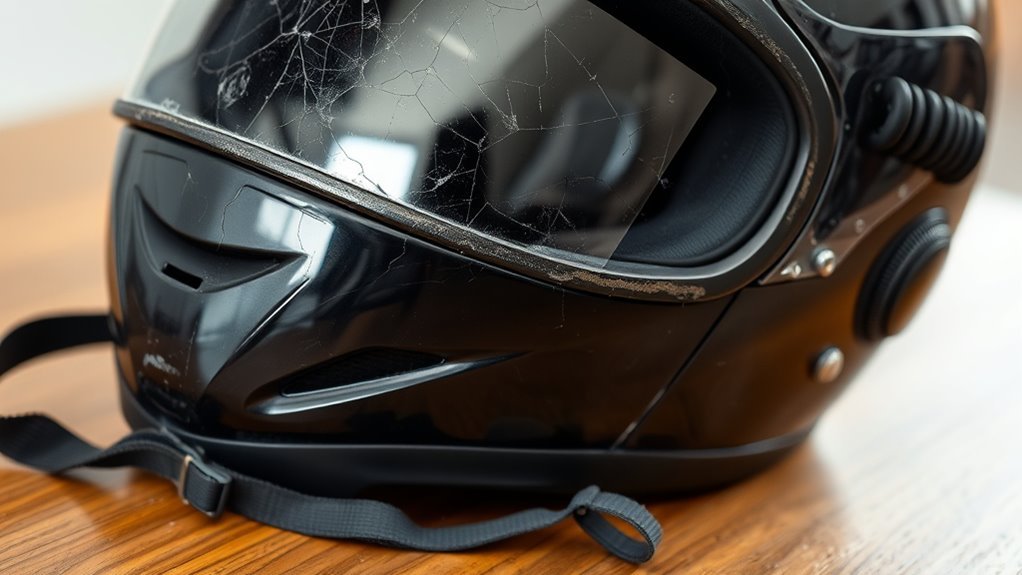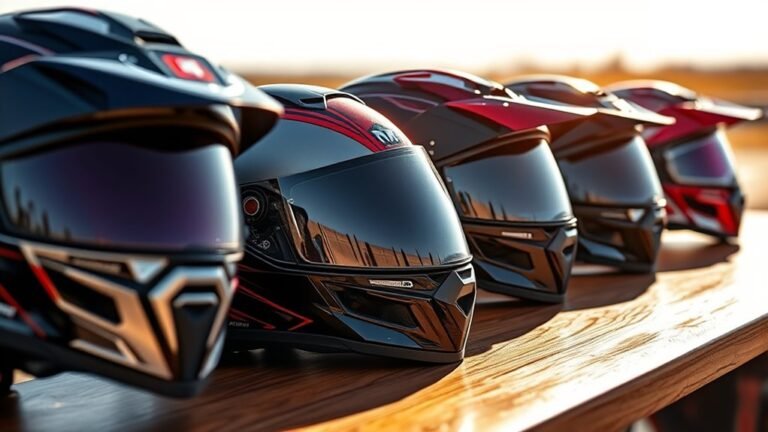Signs Your Motorcycle Helmet Is No Longer Safe
Your motorcycle helmet might not be safe if you spot visible damage or cracks, as these compromise its integrity. Check the age—helmets should be replaced every five years due to material degradation. If it feels uncomfortable or shifts during rides, it’s time for a new one. Also, inspect the interior padding for wear and verify it has valid safety certifications. Want to know more about maintaining helmet safety?
Visible Damage and Cracks
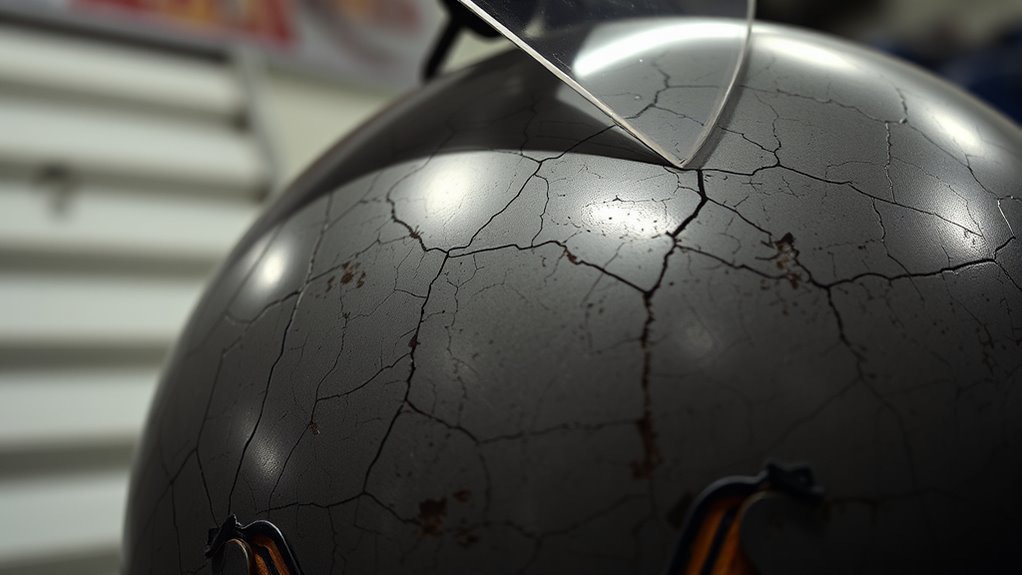
When inspecting your motorcycle helmet, visible damage and cracks are major red flags. These imperfections can compromise the helmet’s integrity, putting your safety at risk. Common impact signs like dents, deep scratches, or any structural deformities indicate that your helmet may not perform well in an accident. Regularly check for these issues as part of your helmet maintenance tips. If you spot any damage, it’s essential to replace your helmet immediately. Remember, your freedom on the road relies heavily on the protective gear you wear. Don’t take chances with your safety—invest in a reliable helmet that can withstand the rigors of riding. Prioritize your well-being and verify your helmet is in top shape before every ride.
Age of the Helmet
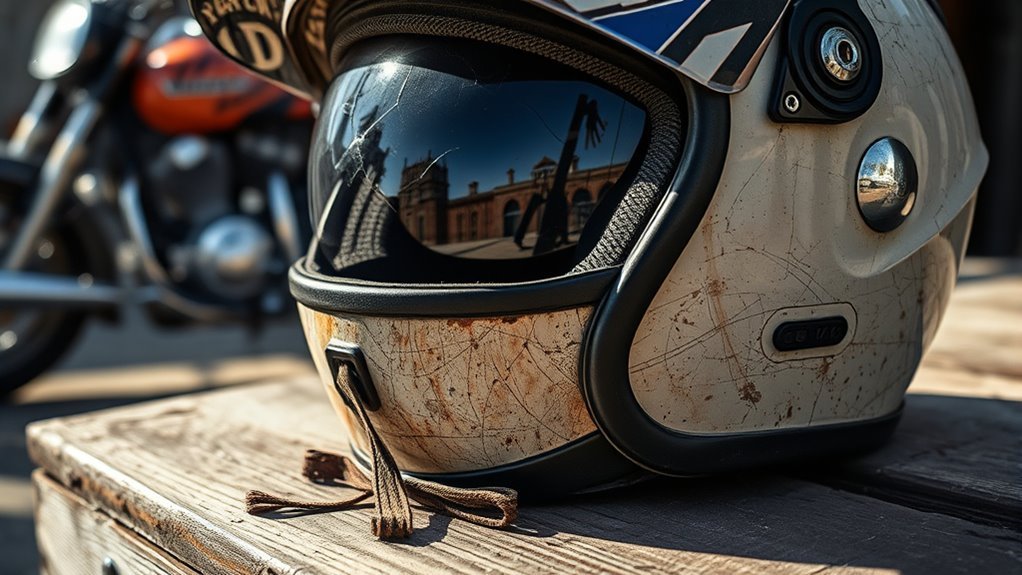
The age of your helmet plays a crucial role in its effectiveness. Over time, materials can degrade, compromising the helmet’s ability to protect you. Most manufacturers recommend replacing your helmet every five years, even if it looks fine. This is due to the gradual breakdown of materials, which can occur from exposure to UV rays, sweat, and environmental factors. Safety standards evolve, too; helmets made a decade ago may not meet today’s stringent criteria. Riding with an outdated helmet increases your risk, and you deserve a reliable shield when you’re out on the open road. Don’t let age dictate your safety—check your helmet’s manufacturing date and prioritize your protection. Freedom on two wheels requires the best gear.
Uncomfortable Fit
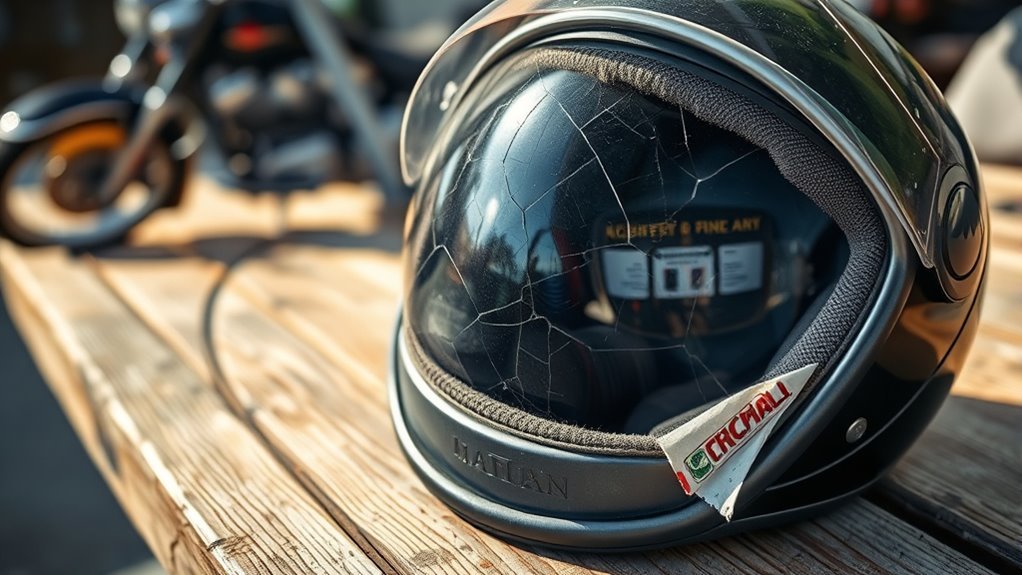
Even if your helmet is relatively new, an uncomfortable fit can render it unsafe. If you’re experiencing pressure points or any discomfort while wearing your helmet, it’s a sign that you may have improper sizing. A helmet that doesn’t fit correctly can shift during a ride, compromising your protection. It should feel snug without causing pain; otherwise, it can distract you from the freedom of the open road. An ill-fitting helmet can lead to fatigue and hinder your focus, putting you at risk. Always verify your helmet fits properly and is adjusted to your head shape. Don’t sacrifice comfort for style—your safety depends on a helmet that feels just right every time you ride.
Compromised Interior Padding
A motorcycle helmet’s interior padding plays an essential role in absorbing impact and ensuring comfort. During your routine interior inspection, check for any signs of wear, such as tears, compression, or deterioration. If the padding feels flat or lacks resilience, it’s time for a padding replacement. Compromised padding not only affects comfort but also decreases the helmet’s ability to protect you in the event of an accident. Remember, a well-functioning helmet is vital for your safety on the open road. Don’t underestimate the importance of keeping your gear in top shape; a quick inspection can save you from serious consequences. Stay free, stay safe, and make sure your helmet’s padding is up to the task!
Lack of Certification or Expired Standards
Checking the interior padding of your helmet is just one part of ensuring your safety on the road. It’s essential to verify the certification validity of your helmet. If it lacks proper certification, or if the standards it meets are expired, you’re putting yourself at risk. Safety regulations evolve, and helmets that once passed may no longer offer adequate protection. Always look for labels indicating compliance with current standards, such as DOT, ECE, or Snell. If your helmet doesn’t have these certifications or if they’ve expired, it’s time to invest in a new one. Remember, true freedom on the road comes with the responsibility of ensuring your gear is up to date and reliable. Don’t compromise your safety.
Frequently Asked Questions
How Often Should I Replace My Motorcycle Helmet?
You should replace your motorcycle helmet every 3 to 5 years, depending on its lifespan and usage. Even if it looks fine, the materials can degrade over time, compromising safety. If you’ve been in an accident or dropped it, it’s best to replace it sooner. Always prioritize your safety and freedom on the road—having a reliable helmet is key. Regularly check for any signs of wear, and stay protected.
Can I Repair a Damaged Helmet Instead of Replacing It?
You can’t reliably repair a damaged helmet. Helmet damage impacts safety, and even minor cracks can compromise its integrity. Repair costs often approach or exceed the price of a new helmet, making replacement the safer choice. Investing in a new helmet guarantees you’re protected while enjoying the freedom of the ride. Always prioritize your safety over temporary fixes; your helmet is your first line of defense against the road’s unpredictability.
What Should I Do With an Unsafe Helmet?
If you’ve got an unsafe helmet, it’s essential to dispose of it properly. Follow local helmet disposal guidelines to guarantee safety regulations are met. Many areas have recycling programs for helmets, so check for options in your community. Never keep a damaged helmet, as it puts your safety at risk. Investing in a new, certified helmet will give you the freedom to ride confidently, knowing you’re protected on the road.
Are All Helmet Brands Equally Safe?
Not all helmet brands are equally safe. Just like a sturdy bridge needs solid construction, a reliable helmet must meet helmet safety standards. Some brands consistently deliver better protection due to rigorous testing and quality control, while others may cut corners. When choosing, prioritize brands known for their reliability and adherence to safety regulations. Your freedom on the road depends on the helmet you wear, so invest wisely for your safety and peace of mind.
How Can I Properly Store My Helmet?
To properly store your helmet, keep it in a cool, dry place away from direct sunlight. Use a dedicated helmet bag for protection and avoid stacking items on top. For helmet maintenance tips, regularly check for any signs of damage and clean it with mild soap and water. Consider investing in storage solutions like wall-mounted racks to keep it safe and accessible, ensuring your gear’s longevity and readiness for your next ride.
